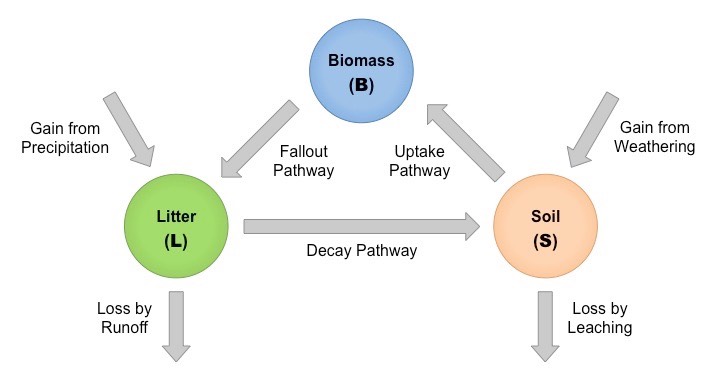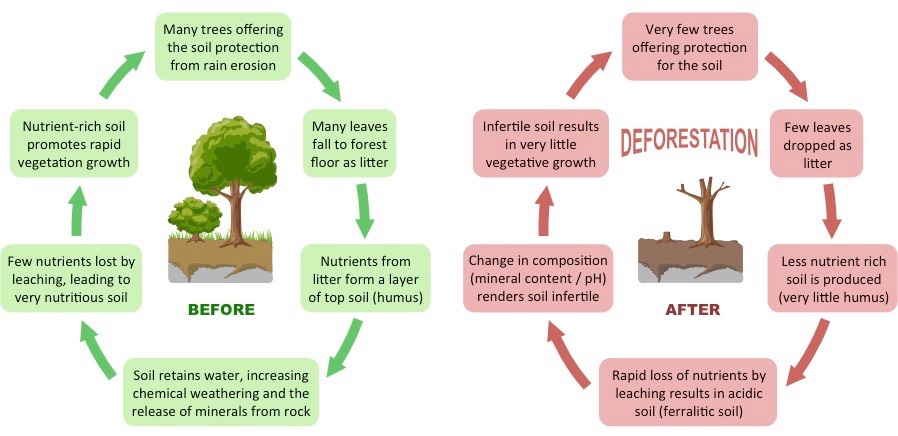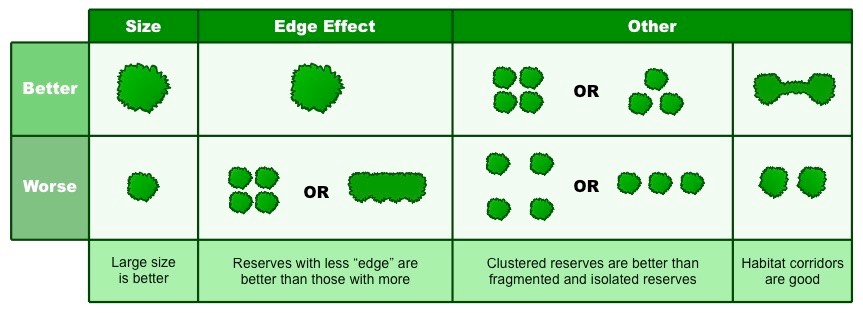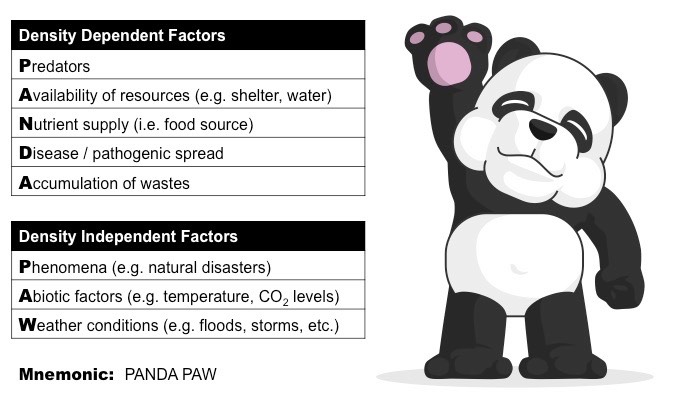Option C: Ecology Flashcards
1/46
Earn XP
Description and Tags
The information on Bioninja on flashcards, basically. All credit to them.
Name | Mastery | Learn | Test | Matching | Spaced |
|---|
No study sessions yet.
47 Terms
Limiting Factor
A component of an ecosystem which limits the distribution or numbers of a population. Can be biotic (intraspecific or interspecific) or abiotic (temperature, light, soil pH, etc…).
Law of Tolerance
Populations have optimal survival conditions within critical minimal and maximal thresholds.
As a population is exposed to the extremes of a particular limiting factor, the rates of survival begin to drop.
Quadrats
Rectangular frames of known dimensions that can be used to establish population densities.
Transects
A straight line along an abiotic gradient from which population data can be recorded to determine a pattern.
Ecological Niche
Consists of all physical and biological conditions which determine the organism’s survival and reproductive prospects.
Habitat, activity patterns, resources, interactions.
Fundamental Niche
Theoretical habitat and may not be fully occupied due to the presence of competing species.
Realised Niche
Actual habitat that is completely occupied by an organism in the presence of competing species.
Competitive Exclusion
One species uses the resources more efficiently, driving the other species to local extinction.
Resource Partitioning
Both species alter their use of the habitat to divide resources between them (i.e. niche separation).
Herbivory
Act of eating only plant matter.
Disadvantage: Certain types of beetle may feed voraciously on the leaves / foliage of crop plants (folivores), causing crop failure.
Advantage: Fruit-eating animals (frugivores) spread the seeds from a fruit in their faeces, promoting overall seed dispersal.
Predation
A biological interaction whereby one organism (predator) hunts and feeds on another organism (prey).
If the prey population drops (e.g. due to over-feeding), predator numbers will dwindle as intra-specific competition increases.
If the prey population rises, predator numbers will increase as a result of the over-abundance of a food source.
Symbiosis
The close and persistent (long-term) interaction between two species.
Can be obligate (required for survival) or facultative (advantageous without being strictly necessary).
Mutualism
Both species benefit from the interaction (anemone protects clownfish, clownfish provides fecal matter for food).
e.g, Honey bees gather food (nectar) from flowers and distributes pollen between plants (mediating plant life cycle).
Commensalism
One species benefits, the other is unaffected (barnacles transported to plankton-rich waters by whales).
e.g., Decorator crabs remove small fragments of tissue from sea sponges and uses them as a source of camouflage.
Paratism
One species benefits to the detriment of the other species (ticks or fleas feed on the blood of their canine host).
e.g., Leeches attach to the skin and drinks the blood of the host animal until fully engorged.
Coral Bleaching
The zooxanthellae within the polyp endodermis which gives the coral its vibrant pigmentation.
When there is a large scale loss of zooxanthellae from the coral (due to environmental stress), bleaching occurs.
When bleaching occurs, coral begins to starve and will die unless the zooxanthellae are restored.
Keystone Species
Has a disproportionately large impact on the environment relative to its abundance.
Ways a Keystone Species Influences its Environment
Predators – they can exert pressure on lower trophic levels to prevent them from monopolising certain resources.
Mutualism – they can support the life cycle of a variety of species within a community (e.g. pollinators / seed dispersal).
Engineers – they can refashion the environment in a manner that promotes the survival of other species.
Biomass
Total dry weight of organic matter in organisms or ecosystems.
Feed Conversion Ratio
Feed Conversion Ratio (FCR) = mass of feed ÷ mass of desired output
Biome
A geographical area that has a particular climate and sustains a specific community of plants and animals.
Gersmhel Diagram

Comparison of Gersmhel Diagrams

The Effect of Deforestation on Nutrient Cycling

Invasive Species
Alien species that has a detrimental effect upon the pre-existing food chains.
Endemic vs. Alien Species
Endemic species are those which are native to a defined geographic region (e.g. koalas in Australia).
Alien species are those that have been transferred from their natural habitat to a new environment.
Advantages of Invasive Species that Allow Them to Displace Endemic Species via Competitive Exclusion
A large fundamental niche (can occupy a wider area than endemic species).
Faster reproduction rates (are capable of forming a larger population than endemic species).
Lack a predator capable of limiting their survival (due to being introduced into a foreign environment).
Possess certain features that are suited to the new environment (e.g. more aggression, better foraging, etc.).
Physical Control
Involves the removal or restriction of invasive species by manual or mechanical measures. (e.g., the installation of barriers and fences, the removal of habitat by excavation or trimming, reduced population numbers by hunting, trapping and culling, etc…)
Chemical Control
Involves the use of chemical agents (poisons and toxins) to limit population numbers and spread (e.g., herbicides (for plants), pesticides (for insects) or other compounds (e.g. rat poison); can detrimentally affect local wildlife and are costly to employ and the effect of chemical agents may become more pronounced in higher trophic levels due to biomagnification.)
Biological Control
Involves using a living organism (or a virus) to control an invasive species (may eat the invasive species (predation) or cause it to become diseased, must be carefully assessed before release to ensure they do not become invasive themselves, must be monitored for unintended side effects (e.g. development of immunity in invasive species).)
Biomagnification
Where chemical substances become more concentrated at each trophic level.
Occurs because organisms at higher trophic levels must consume more biomass to meet requirements.
DDT
A chemical pesticide that is sprayed on crops and subsequently washed into waterways at low concentrations, it was widely employed as a chemical pesticide in the 1940s and 1950s to control insect-borne diseases like malaria.
Arguments for DDT Spraying:
DDT spraying is an affordable and effective means of killing mosquitos that carry disease (malaria, dengue fever, etc.)
Where the use of DDT has been discontinued, the incidence of malaria and associated deaths have increased
Health costs associated with the treatment of malaria are reduced when DDT spraying is implemented
Alternative strategies are not as cost-effective or successful
Arguments against DDT Spraying:
DDT spraying is associated with adverse health effects in humans (cancer, birth defects, reduced fertility, etc.)
DDT persists in the environment for long periods of time (more than 15 years)
DDT is biomagnified in higher order consumers, which has adverse consequences on ecosystems
Indicator Species
Sensitive to specific environmental conditions and consequently have a limited range of tolerance.
 A high biotic index indicates the presence of many pollution-sensitive organisms, denoting an unpolluted environment.
A high biotic index indicates the presence of many pollution-sensitive organisms, denoting an unpolluted environment.
A low biotic index indicates a polluted environment, due to a relative abundance of pollution-tolerant organisms.
Richness
Number of different species present in an area (more species = greater richness).
Evenness
Relative abundance of the different species in an area (similar abundance = more evenness).
Biogeographic Factors

Island Size
Biodiversity of an island is typically proportionate to island size (i.e. larger islands have greater biodiversity).
Larger islands support a greater range of habitats (and hence more available niches for species to occupy)
Larger islands can sustain higher population numbers for each species (increases species evenness)
Larger islands have greater productivity at each trophic level, leading to longer and more stable food chains
Edge Effect
Diversity of species within a given environment changes with proximity to the ecosystem’s boundaries (edge effect).
Biodiversity may be greater at the border between two ecosystems as different abiotic factors favour certain species
However certain species may not be able to thrive under these conditions and instead must occupy more central regions
The effect of edges on biodiversity will be greatly influenced by the particular conditions caused by the ecological disturbance
In Situ Conservation
Within natural habitat.
Advantages:
Allows species to live in the environment to which they are adapted and to occupy their natural position in the food chain
Maintains the animal's normal behaviour (offspring usually aquire skills from parents and peers around them)
Prevents eventual habitat loss and ensures it remains available for other endangered species
Such areas provide a place to return animals from breeding programs as they provide realistic conditions for reintegration
Reserves in different areas can share information and provide a place for scientific study and developing public awareness
Disadvantages:
Ecological monitoring of species may be required to ensure viable population levels are maintained
Interventions may be required to prevent habitat degradation or competition from invasive species
Legislation may be necessary to ensure adequate funding for policing and education
Ex Situ Conservation
Outside natural habitat.
Advantages:
It allows for greater control of essential conditions (e.g. climate control, dietary intake, veterinary care, etc.)
It can improve the chances of successful breeding by utilising artificial methods (e.g. embryo transfer, IVF, etc.)
Disadvantages:
Such conservation methods do not prevent the potential destruction of their natural habitats
Species raised in captivity are less likely to be successfully reintroduced into the wild (loss of autonomous survival)
Ex situ conservation increases inbreeding by restricting the gene pool and restricts the evolution of the species
Population Size
Population Size = (Immigration + Natality) – (Mortality + Emigration)
Population Sampling
Involves identifying individual numbers in small areas and then extrapolating to estimate population totals.
Capture-Mark-Release-Recapture

Population Growth
Exponential vs. Logistic
Exponential Growth
Ideal environment (unlimited resources, no competition etc…)
Logistic Growth
Population numbers begin to approach a finite carrying capacity.
Limiting Factors
